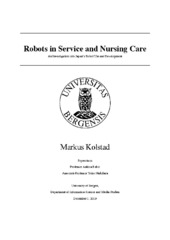| dc.description.abstract | We are currently seeing a rapid growth in the investment and development of robots to assist or replace human workers and efforts in many aspects of life. Due to Japan’s proportionally large and growing elderly population along with a shrinking workforce, the Japanese government has chosen to promote the research, development, and use of robots in fields such as nursing care. Other countries are also facing the same problems as Japan but have not chosen to promote the alternative futuristic solution to the same extent. In a pursuit to better understand the impact that robots already have and will have on society and everyday life, we have researched the topic of assistive robots in the service and nursing care context. Through a design science framework and mixed methods approach, performing semi-structured interviews with robot developers, professors in robotics and nursing care staff, observations on the use of robots in real-life settings, case studies, and one experiment, we have developed a comprehensive analysis and understanding of the research problem. To analyze the data, content analysis and the grounded theory were used. An experiment and two case studies were used to investigate attitudes, perceived benefits, and disadvantages of using robots. Furthermore, interviews and observations were conducted at nursing care facilities to investigate the possibility of assisting or even substituting humans with robots in settings that usually require a sense of human warmth and care. Previous research often focusses on individual robots or on literature review without field data. It would seem like the literature is lacking a deeper perspective, while at the same time, painting a wider picture of the domain itself. Therefore, this research investigated the development and experiences with robots that already exist and have been tested in real-world settings. The findings of the study summarized the literature on robots in nursing care, attitudes towards robots across countries and Japan’s strategy for further integrating robots into their society. Other results include real experience with the use of robots in nursing facilities and theories grounded in the ideas and thoughts behind the development of robots commonly used today. An experiment exploring empathy towards robots demonstrated the distinctiveness of robots, as compared to dolls, in enhanced empathy towards them. Two case studies captured views from university students and primary school pupils based on interaction with the humanoid robot Pepper. Pupils found Pepper to be useful and likable, while university students found the interaction to be fun, but frustrating at times. Based on the field studies, we could conclude that Japanese robot developers and researches recommend robots to be inferior to users in terms of intelligence and relationship, but also capable of easy interaction and ideally reading between lines in communication. In nursing care, robots are currently taking the role of pets (Paro and Qoobo), a child (Pepper, Paro, PALRO, RoBoHon, and Smibi) and even as a staff member (Pepper), capable of entertaining and accompanying elderly to help with mental well-being. There might be a current lack of ethical and safety standards for such robots. However, safety and ethical issues are considered by developers and professors in terms of privacy, deception, attachment, mechanical safety. Current robots have different levels of cognitive capacities depending on purpose and interaction style. Goals for the future include improvement in aspects such as intelligence, marketing strategies, and educating users on robots’ capabilities and limitations. | en_US |
